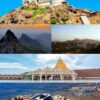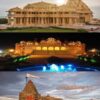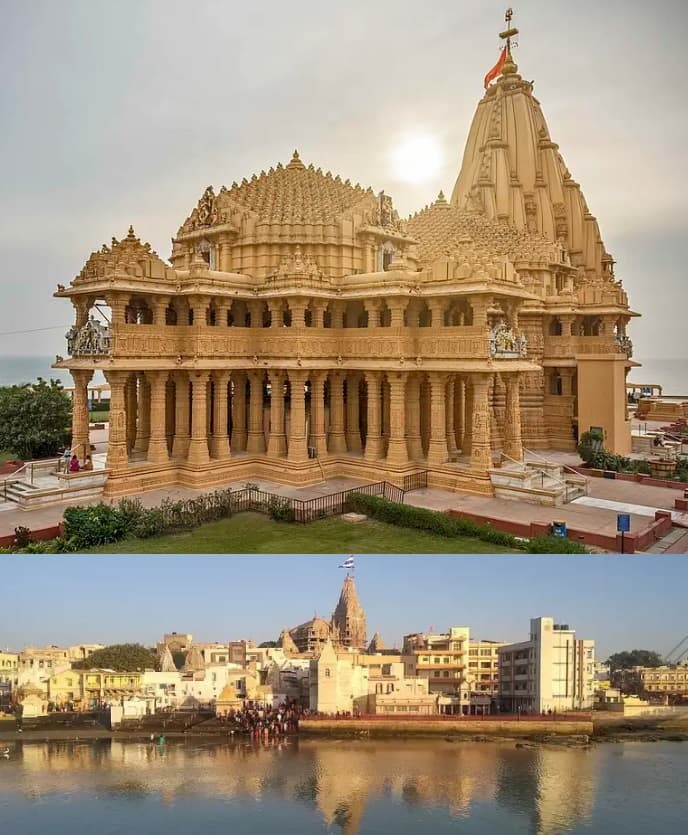Explore Divine Wonders: A 5-Day Spiritual Journey to Dwarka and Somnath
By Road – Ahmedabad To Dwarka >> Dwarka Temple Tour >> By Road – Dwarka To Somnath >> By Road – Somnath To Ahmedabad >> By Air/Train – Depart Ahmedabad
Warm Greetings from Spritural World!
Entering a spiritual odyssey through Dwarka and Somnath unveils a transformative 5-day journey. Commence amidst the sacred aura of Dwarka, where the Dwarkadhish Temple exudes timeless spirituality. Journey onward to Somnath, nestled along the Arabian Sea, where the revered Somnath Temple stands majestically. Each passing day unfolds a fresh chapter of profound significance, intricately weaving a connection to the spiritual heritage of these captivating destinations. Beyond a mere physical expedition, this spiritual sojourn pledges a stirring awakening amidst the ancient and sacred landscapes of Dwarka and Somnath.
Explore Divine Marvels: Dwarka and Somnath Unveiled in a 5-Day Spiritual Tour
Dwarka and Somnath 5 Days Itinerary
Day 01 – By Road – 450 Kms / 09 Hrs – Ahmedabad To Dwarka
• Arrive Ahmedabad in morning & drive to Dwarka.
• Dwarka: An ancient city, housing one of the principal pilgrimages – ‘Dwarkadhish temple’ of Hindus. According to the legend, Lord Krishna moved to this coastal town to set up a capital. Marine excavations of the Dwarka coast have revealed important evidence of the ancient city, which probably include the ‘Dwarawati’ of the ‘Krishna Lila’. Today, it is not only a major pilgrimage site but a pleasant spot for a beach holiday.
• Another popular place in Dwarka, part of the Dwarkadhish Temple is Sabha Mandapa. It is a 60-pillared hall, which houses almost 2500 years old scriptures. The hall has ‘Jharokhas’, offering a nice view of the nearby flowing Gomati River.
• Attending evening Aarti at Dwarkadhish temple.
• Overnight at hotel.
Day 02 – In Dwarka
• After breakfast proceed to Bet Dwarka & Nageshwar temple.
• Bet Dwarka: Bet is situated at 30kms from Dwarka and is surrounded by sea from all sides. One can reach Bet from Dwarka through Okha by road. On reaching Okha port jetty, one can reach Bet through a little sea journey by a small boat.
• Nageshwar Temple or Nagnath Temple is located on the route between Gomati Dwarka and the Bait Dwarka Island on the coast of Saurashtra in Gujarat. The Jyotirlinga enshrined in the Temple of Nagnath is known as Nageshwar Mahadev and attracts thousands of pilgrims all-round the year. This powerful Jyotirlinga symbolizes protection from all poisons. It is said that those who pray to the Nageshwar Lingaa become free of poison. The Rudra Samhita shloka refers to Nageshwar with the phrase ‘Daarukaavane Naagesham’.
• The Rukmini Temple, dating from 12 to 13 Century, was built in honour of Rani Rukmani, princess of Vidharba, which was to be married to Sishupala, but fled with Lord Krishna. This small temple, 1.5 km north of the city, is an architectural masterpiece. The temple walls are decorated with beautiful paintings and sculptures.
• Gopi Talav: This is the place where Lord Krishna used to play with his Gopikas. There is a small pond where it is said that Lord Krishna used to play with the Gopika Strees (Gopika Women).
• Overnight at hotel.
Day 03 – By Road – 250 Kms / 05 Hrs – Dwarka To Somnath
• Early morning visit the Dwarkadhish Temple and witness the Aarti.
• After breakfast drive to Somnath visiting Porbandar enroute visit Porbandar, the coastal heritage town of Gujarat is located on the Saurashtra peninsula, on the Arabian Sea. This city is described in Skanda Purana as Sudamapuri and Ashmavati and had a flourishing trade with Africa and Arabia. Till date, the spice market in Porbandar draws a huge crowd. According to the legends, this city was the main link of the great friendship between Lord Krishna and Sudama. Porbandar was established as a capital by Rana Sartanji in 1785 AD. Porbandar was the former capital of the Jethwa Rajput petty princely state.
• The most impressive feature of Porbandar is the city planning and the stone buildings with ashlar masonry and rich carving, the facades of the houses on either side of the streets, with windows and carved gateways. Porbandar is also associated with Mahatma Gandhi, the father of the nation as he was born here. Today, fine quality silk and cotton are manufactured here. There are also chemical factories and cement works.
• Later visit Kirti Mandir – Kirti Mandir was the house of Mahatma Gandhi and Kasturba, his wife. This place is situated near the place where the Mahatma was born. This place is now a small museum and also has a Gandhian library and a prayer hall. Bharat Mandir is another place to visit, which houses relief map of India and reliefs of great historical personalities who shaped India’s future.
• Later continue to drive to Somnath: arrive at Somnath and transfer to your hotel.
• Somnath consists of a few streets leading away from its phoenix like temple. The rugged sea below gives it a lonely, wistful charm. Somnath is mainly known for the legendary shore temple of Somnath, which is dedicated to the Lord Shiva. The temple is an example of grit and determination and how to rise out of downfall as the temple has been plundered and destroyed many times and re-erected again in all its glory. To be precise, destroyed seven times and built eight! The legendary shore temple of Somnath is one of the twelve most sacred shrines dedicated to the Lord Shiva. The temple contains the Jyotirlinga of Lord Shiva. According to the legends, the Somnath temple is very old and was originally built in gold by the Somraj, the Moon God. Later, it was rebuilt by Ravana, in silver; then by Krishna in wood and Bhim Dev in stone. Mahmud of Ghazni, upon hearing the description of the richness of the Somnath temple by Al Biruni, an Arab traveller, visited this temple in 1024 AD. At that time, this temple had about 300 musicians, 500 dancing girls and 300 barbers to shave off the heads of pilgrims. After a two day’s battle, Mahmud destroyed the temple and carried away jewels and gold to his homeland. In all, the Somnath temple was rebuilt and destroyed eight times. This temple was finally rebuilt in 1950 with the support of Sardar Vallabhbhai Patel. The current temple was built as per the traditional designs on the original site by the sea and is a serene, symmetrical and sinuous structure. Today, this majestic temple is a replica of the earlier temple.
• Later visit Bhalka Tirth – Bhalka Tirth is situated halfway between Veraval and Somnath. At this place, Lord Krishna was mistaken for a deer and wounded by an arrow. It is here that Lord Krishna decided to leave his human form and proceed to the eternal world.
• Overnight at hotel.
Day 04 – By Road – 415 Kms / 08 Hrs – Somnath To Ahmedabad
• After breakfast drive to Ahmedabad, arrive and transfer to your hotel.
• Ahmedabad, founded in the year 1411 AD, is located on the banks of river Sabarmati and has been named after Sultan Ahmed Shah, who was primarily responsible for building it. Today, this city is known as the ‘Manchester of the East’, one of the highly industrialized cities in India and is also India’s Textile City. Though the capital of Gujarat was shifted from Ahmedabad to Gandhinagar, it is still the second largest industrial city in western India.
• The old city of Ahmedabad is dotted with labyrinthine by-lanes called ‘polls’. The exquisite carved wooden mansions and havelis are marvellous. The city also offers a rich architectural legacy that blends Hindu and Muslim schools of architecture, stone and brick with arches, domes and vaults, carved pillars, trefoil designs besides the modern buildings designed by the famous French architect, Le Corbusier, and Louis Kahn.
• Overnight at hotel.
Day 05 – By Air / Train – Depart Ahmedabad
• Today in time transfer to Ahmedabad Airport / Railway Station to board your flight / train for an onward journey to your next destination.
Hotels Used: 4* (Four Star)
Per Person cost @ Rs 21,199/- (Costing based on Min 02 paying pax)
Cost Inclusion:
• 04 Night accommodation at the hotel mentioned above or similar category of alternate hotels.
• Meal Plan – As Mentioned above.
• All currently applicable taxes.
• All transfers, city tours and transport services by air-conditioned All India Tourist permit Vehicle as per the above itinerary.
• Road taxes, parking fee, fuel charges, interstate taxes.
Cost Exclusion:
• Monument Entrance Fee.
• Services of English-Speaking Local Guide.
• Game Drive at Sasangir National Park or any other national park.
• Expense of personal nature like tipping, laundry, telephone / fax calls, alcoholic beverages, camera/video camera fee at monuments, medical expenses, airport departure tax etc. Any other services not mentioned in the inclusions.
• International or Domestic airfare / Train Fare.
• Any expenses caused by reasons beyond our control such as roadblocks, accidents & any medical evacuations. Any train delays, or re-scheduling etc. Any Visa fees, insurance fees, etc. Any tips to hotel staff, local guides, drivers etc. Any meals apart from the ones mentioned above. Any expenses apart from the ones above.
* Accommodation on Double-sharing basis.
* Itinerary includes flexible timings and is subjected to climate conditions and fleet availability.
* In case of any confusion or queries, feel free to connect with our travel experts to help you right away.
Other Packages:
Lucknow and Ayodhya Tour
Religious Uttar Pradesh Tour
Holy Trail Including Ayodhya, Prayagraj & Varanasi
Some Guidelines for Tourists on Odisha Spiritual Essence Tour
If you’re planning a Odisha Spiritual Essence Tour for 3 Nights/4 Days with us, it’s essential to have a well-organized itinerary and be aware of certain guidelines to make the most of your trip. Here are some general guidelines:
Itinerary Overview:
• Understand the day-wise itinerary provided by the travel company.
• Know the major attractions you will be visiting each day.
Accommodation:
• Confirm the details of your accommodation, including the hotel names and addresses.
• Ensure that you have contact information for the hotels and the travel company.
Respect Local Customs:
• Be mindful of the local customs and traditions, especially in religious places.
• Dress modestly, covering shoulders and knees, when visiting temples or sacred sites.
Footwear Etiquette:
• Remove footwear before entering temples or any sacred premises.
• Carry socks if needed, as some places may require them.
Photography Rules:
• Respect rules regarding photography in religious or sensitive areas.
• Always ask for permission before taking pictures of people.
Cultural Sensitivity:
• Maintain a respectful demeanor in spiritual places.
• Keep noise levels to a minimum, especially in prayer areas.
Guided Tours:
• Pay attention to the guidance provided by local guides.
• Ask questions to enhance your understanding of the cultural and spiritual significance.
Silence and Reflection:
• Take moments of silence for personal reflection in spiritual places.
• Respect the meditative atmosphere, refraining from loud conversations.
Sacred Offerings:
• If allowed, participate in local customs like offering flowers or lighting incense.
• Follow the guidance of locals when engaging in spiritual rituals.
Environmental Responsibility:
• Dispose of waste responsibly, especially in natural or spiritual sites.
• Avoid littering and contribute to the preservation of the surroundings.
Free Time:
• Make the most of free time to explore on your own.
• Use local transportation or explore nearby attractions.
Hydration and Comfort:
• Stay hydrated, especially in warm weather, by carrying a water bottle.
• Wear comfortable clothing and footwear for ease during temple visits.
Local Cuisine and Fasting Days:
• Respect local dietary practices, especially during fasting days.
• Enjoy local cuisine but be mindful of dietary restrictions in spiritual places.
Emergency Preparedness:
• Have emergency contact numbers on hand.
• Know the location of the nearest medical facilities and pharmacies.
Engage with Locals:
• Interact with locals to gain insights into their spiritual practices.
• Be open to learning and understanding diverse perspectives.
Memories:
• Reflect on your experiences and the spiritual journey you’ve undertaken.
• Share your stories and newfound knowledge with friends and family.
By following these guidelines, tourists can enhance their spiritual journey in Odisha while fostering cultural respect and creating a positive impact on the local community.
CANCELLATION/REFUND POLICY
If passengers wish to cancel their booking, then they will have to pay following cancellation charges
- More than 15 days before the departure date – 70% of total tour cost will be refunded.
- Between 08th to 15th day before departure date – 50% of total tour cost will be refunded.
- Up to 07th day before the departure date – No Refund.
- No show – No Refund.
- Cancellations after commencement of tour – No Refund.









Reviews
There are no reviews yet.